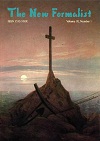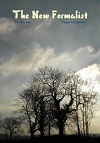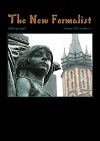After the war the “Dada” movement was evolved in conversations which were held at the Closerie des Lilas and at other cafés. I knew most of the “Dadas.” They were extremely talented. They spent their nights in reading Leibnitz and their afternoons in admiring Charlie Chaplin. But when they appeared in their rôle of Dadas, crying haro on all writers and painters who had preceded them, they were nonsensical, obscene, incorrigible fumistes.
It is useless to search for meanings or for tendencies, for there is neither meaning nor direction in Dadaism. The Dadas as individuals may quite possibly achieve worthy works, but these will have nothing to do with Dadaism. As a matter of fact, the members of any literary or artistic school, if they are notable, are notable in themselves and not as members of the school. The Decadents and the Symbolists were good only in so far as they possessed personal ability and not as Decadents and Symbolists. I state this truism because it is necessary to emphasize the distinction between the talent of the Dadas and the foolishness of Dadaism.
Let me describe a night with the Dadas. We met in a little theatre at Montmartre. The spirit of the proceedings may be indicated by the fact that continually the Dadas called us idiots, for having been induced to waste good money on them. If you make fun of the public, they said, the public will like you. If you call the public hard names the public will admire you. If you say absurd and incomprehensible things the public will worship you.
The Dadaistes tried to ascertain how far the public could be taken in. Apparently there is no limit to the credulity of the public. Francis Picabia, a really clever artist in spite of his clowning, in his manifesto declared quite frankly: “You are all dupes (des poires). In three months we will sell you, I and my friends, our pictures for a good deal of money.” The audience found this witty and not at all abusive. The writers in the French reviews discussed Dadaism seriously, even solemnly, endeavouring to give a definition to this final efflorescence of the human intellect. And the true Dadas (though there are undoubtedly Dadas who are themselves dupes, and take themselves gravely) laughed aloud.
In a few months, by dint of repeated stupidities, the Dadas made themselves talked about more than Henri Barbusse, or Zola, or Joseph Conrad, or H.G. Wells, or Arnold Bennett were talked about after many years of conscientious work. Everybody was anxious to know what they were driving at. Their names were on every tongue in French literary circles, and they secured a world-wide fame. Sweet are the uses of advertisement!
Incidentally, they had a good deal of fun.
Tristan Tzara, the literary leader of the movement, is a Rumanian. He invented a Dadaphone. The Dadaphone is an instrument which looks like a coffee mill and emits the same kind of sound. The sound is magnified to a terrifying degree. Standing on the little stage he turned the handle and then cried “Dada, Dada, Dada,” to which the audience replied “Dada, Dada, Dada.”
But there is a Dadaism adapted to the piano. Ribemont-Dessaignes was the chief composer of Dada music. A piece entitled “Pas de la Chicorée Frisée” was played. The recipe for the composition of this kind of music is simple. You bang the same note in the upper octaves many times in succession, at the same time banging a discordant note in the lower octaves with the other hand. Then you jump about at random on the keyboard, returning to the original note. The result is the most dreadful cacophony.
Of the little plays that were presented the best was entitled “The Silent Canary.” An eccentric man mounted a high ladder and talked nonsense with a philosophical air, while on the stage a girl proclaimed herself Messalina, and a black man insisted many times that he was Gounod. It was funny just because it was so senseless. Yet my neighbours, who were determined to find some sense in it, assured me that although it was not easy to put into words the profound significance of such a play, it was veritably an event in the history of the drama. The girl next to me clutched my arm and exclaimed: “One does not know what it signifies but one feels that there is so much behind it.” The Dadas reckoned upon this capacity of self-mystification that is in all of us.
The most pretentious of the plays was Tzara’s “First Heavenly Adventure of M. Antipyrine.” There were eight characters whose costumes were designed by Picabia. The costumes consisted of tubes of cardboard which hid the faces of the actors. The eight players stood in a row and recited in turn meaningless speeches. Lest someone should accuse me of coming to hasty conclusions, I will translate a typical Tzara production:
“The equatorial bite in the bluish rock weighs upon the night intimate scent of ammoniacal cradles the flower is a lamp-post doll listens to the mercury which mounts which shows the windmill holding on the viaduct before yesterday is not the ceramic of the chrysanthemum which turns the head and the cold the hour has sounded in your mouth once more a broken angel which falls…”
When it was all over we were once more informed that we were imbeciles and told to get out.
—from Paris Salons, Cafés, Studios (1928)



